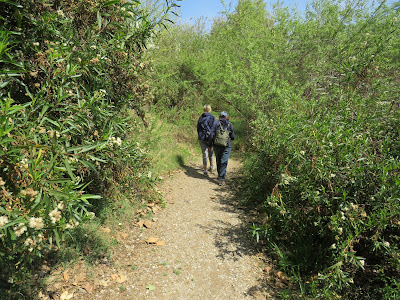The midday sky is sunny with temperatures in the low 60’s and a steady westerly breeze as we hike in the 13-acre, Willow Wetlands Preserve in Gardena, California, 15 miles south of Los Angeles. In the mid-1970s, the City of Gardena planned to fill in this land and build a convention center. However, residents fought to stop destruction of the wetlands and preserve its value as a green oasis, a migratory stop for ducks, a home for resident birds, a haven for reptiles and amphibians and a natural mechanism for cleaning street runoff water before making its way to the Pacific Ocean. Immediately, colorful spring blossoms of Wood-sorrel and Poppy are a welcome sight. Just ahead, I watch a Monarch flutter around before landing on a Coastal Sunflower head. Scanning a pile of fallen branches, I catch a glimpse of a 4-inch, well-camouflaged Western Fence Lizard. These reptiles can “throw” their tail to get away from an enemy. Eventually, the tail will grow back; however, the female is very picky about courtship and won´t even look at a male who has lost its tail. Also, their powerful hind legs allow them to run fast and quickly change directions to escape predators. Other methods of escape include their ability to jump and rapidly climb trees. Following the path next to a busy street, I notice a blossoming cherry tree and a patch of blossoming Nasturtium while from a shallow pool, hidden my dense underbrush, I hear the familiar call of a Mallard. Up ahead, I watch a fast-moving, orange butterfly finally land so I can identify it as a Gulf Fritillary. This is one of several species being mass-reared commercially for release at outdoor events like weddings and garden parties. If done properly, it is a harmless and esthetically pleasing addition to the environment that may even help revive declining populations. Continuing down the trail, I pause to watch several honeybees feeding on blossoms of Black Sage and then spot blossoms of California Lilac. Rich in saponins, these flowers can be crushed and mixed with water to produce an excellent lather which is an effective and gentle soap. They were used by the North American Indians as a body wash, especially by the women in preparation for marriage, since they left their skin smelling fragrantly. Also known as ‘New Jersey tea’ , lilac leaves were used as a tea substitute during the American Revolution. Before leaving the preserve, on this first full day of astronomical spring, I pause to recognize the shining sun that reached its vernal equinox yesterday.
Star of earth
Sun of sky
We celebrate
Your place on high
Star of earth
Path ascends
Your energy
All life depends
Star of earth
Light of days
Glowing orb
You I praise
D. DeGraaf

Beautiful. Thank you.
ReplyDelete